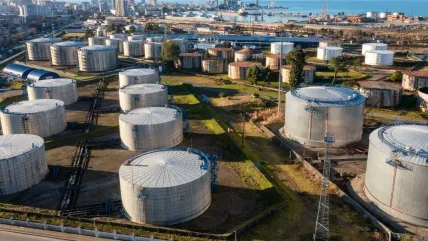
Oil markets saw a 1% uptick on Monday, driven by US tariff exemptions and a notable rise in China’s crude imports for March.
This development resulted in Brent crude futures climbing by 63c to $65.39 per barrel, while US West Texas Intermediate (WTI) crude prices increased by 64c to $62.14 per barrel as of 1026 GMT, reported Reuters.
Harry Tchilinguirian from Onyx Capital Group stated that recent tariff exemptions have shifted market sentiment positively. However, Tchilinguirian also pointed out the persistent policy risks tied to the unpredictable nature of current trade strategies.
Recent data indicates China’s crude imports experienced a significant rebound in March, nearly 5% higher than the same period last year. This growth was supported by increased Iranian oil imports and a recovery in Russian deliveries.
Despite these gains, Brent and WTI prices have fallen by about $10 per barrel since the beginning of the month due to escalating trade tensions between the US and China.
In its projections, Goldman Sachs anticipates that Brent will average $63 and WTI $59 for the rest of this year, with expectations for further decreases to $58 and $55 respectively in 2026.
The bank foresees only a modest rise in global oil demand in the latter part of 2025, predicting an increase of merely 300,000 barrels per day (bpd) year-on-year. It highlights that petrochemical feedstocks may experience a marked slowdown in demand.
According to BMI, a division of Fitch Solutions, the spread between Brent crude prices for December 2025 and December 2026 has shifted into a contango state. This situation highlights the market’s concerns about potential oversupply and uncertain demand outlooks.
In a contango market scenario, spot prices are lower than prices for future delivery dates, indicating that supply is not currently constrained, as per the Reuters report.
Amid forecasts for decreased demand, the US oil and natural gas rig count has dropped for three consecutive weeks, according to Baker Hughes reports. Concurrently, US Energy Secretary Chris Wright mentioned that halting Iranian oil exports could be part of strategies aimed at applying pressure on Tehran regarding its nuclear programme.
Goldman Sachs has also revised global demand growth forecasts downward for late 2026 by 900,000 barrels per day (bpd) amid worsening trade relations between the US and China.
Despite potential inventory accumulations factored into market expectations, significant surpluses are anticipated to continue influencing price trends negatively in upcoming years. Additionally, Goldman Sachs has adjusted its US shale supply forecast for late 2026 downward by 500,000bpd.






